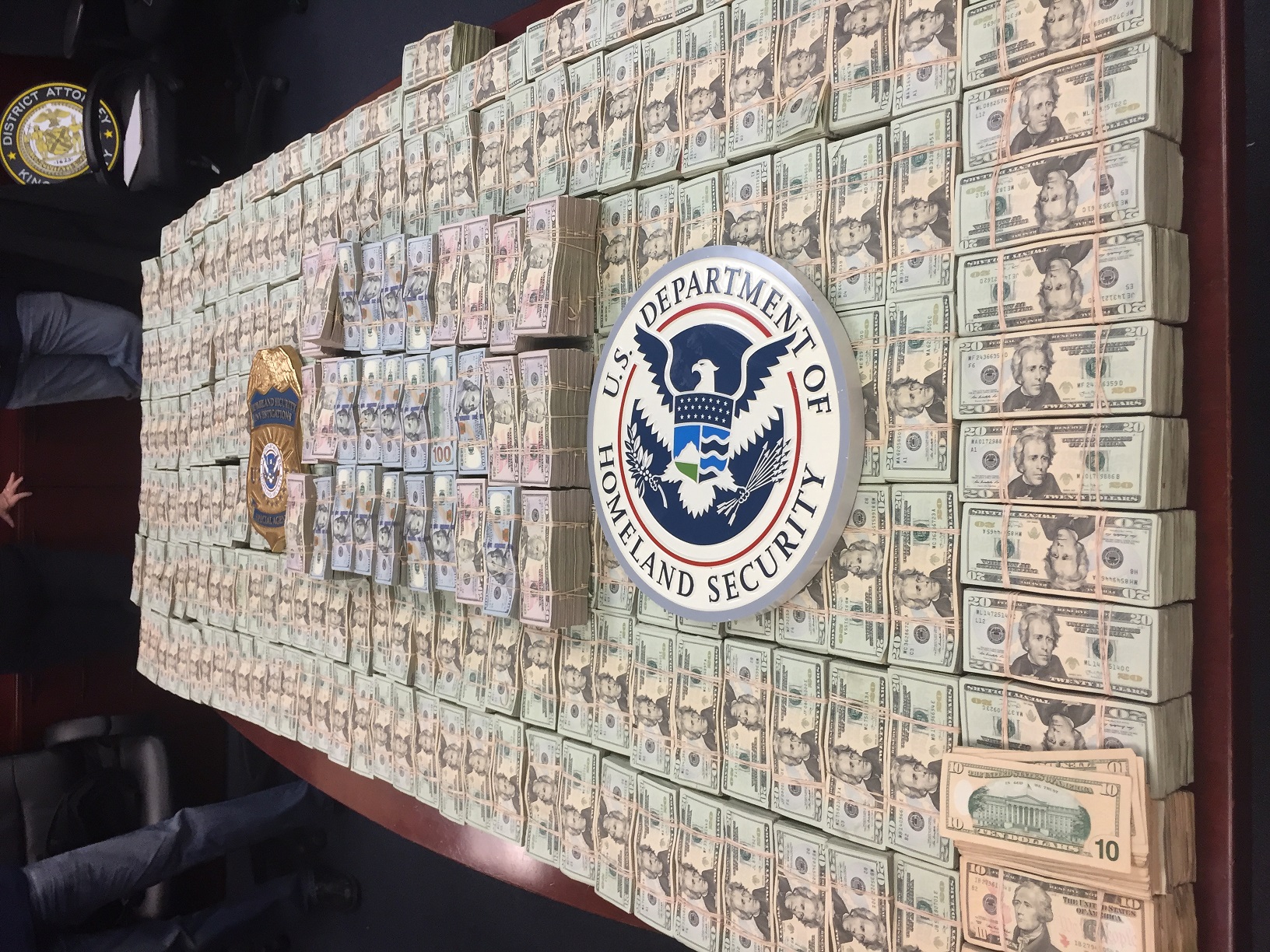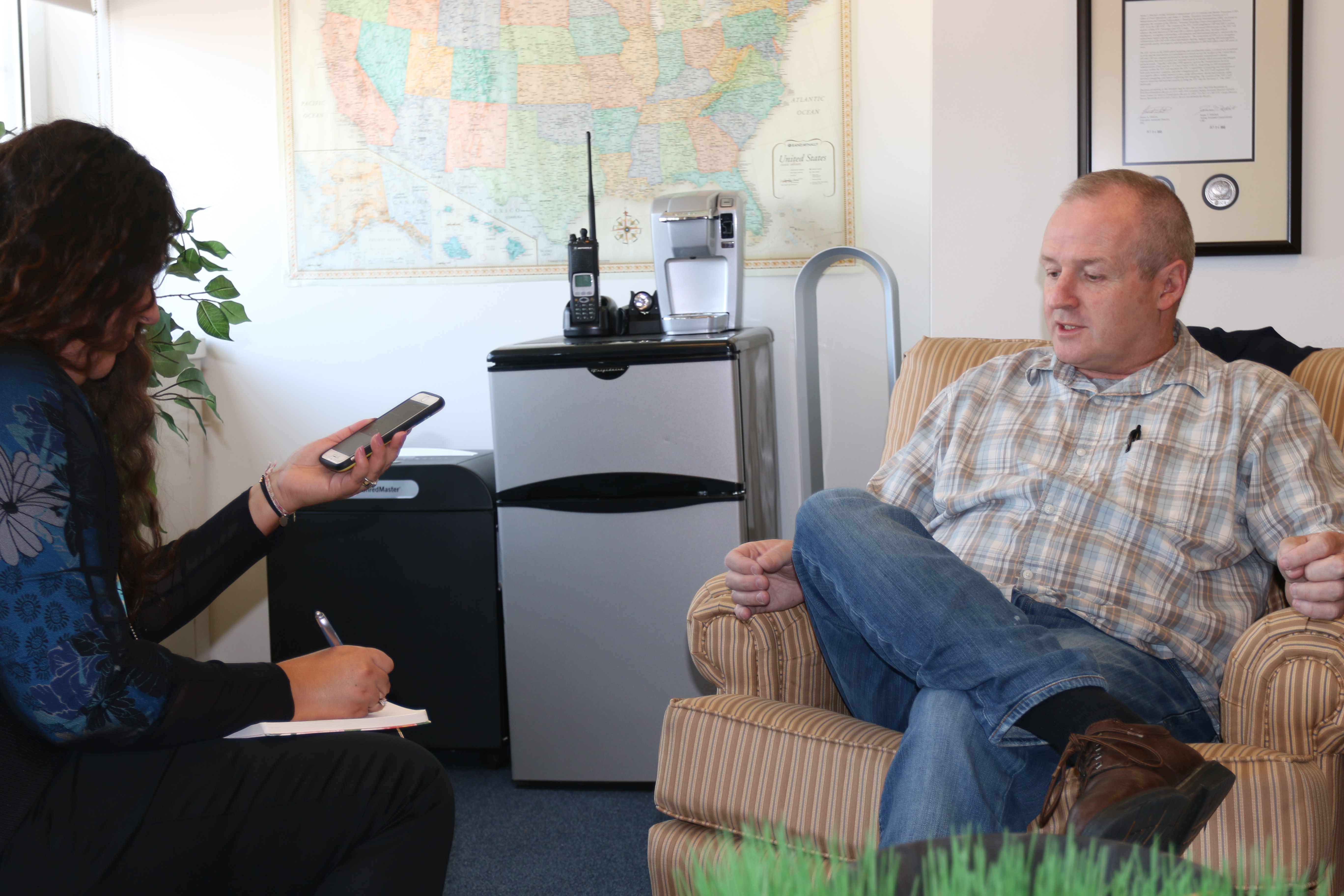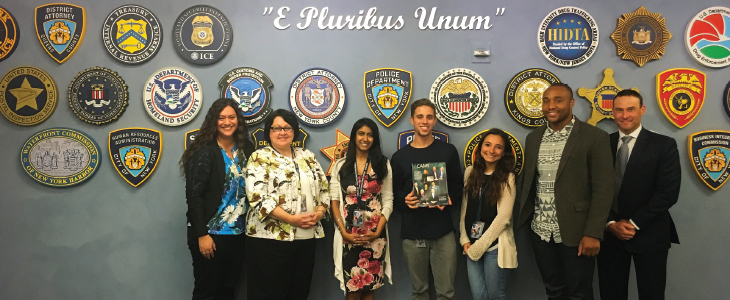
Amidst the legions of buildings in Midtown Manhattan, New York City, sits an expansive, nondescript, yet historic redbrick building. From the outside, one would never guess that the 30 different agencies operating within the building comprise the Homeland Security Investigations (HSI) El Dorado Task Force (EDTF). HSI EDTF has been crime fighting for the last 25 years. They have cracked some notorious cases and brought down some infamous criminals. This year commemorates 25 years of fighting crime and many successes. ACAMS Today
was fortunate enough to spend the day with HSI EDTF and to catch a glimpse of their fascinating crime-fighting world. What follows is a transcript of recollections, impressions and interviews from my day with what I consider some of the real heroes of New York City.
As we approached the building in his vehicle, Erik Rosenblatt, HSI EDTF’s assistant special agent in charge, pointed out that the parking level where we drove up was used in 2001 as the U.S. government’s World Trade Center central command after the 9/11 terrorist attacks. The building covers an entire city block and back then there were not a lot of neighbors in the neighborhood. Things have definitely changed since then. Now, storefronts for numerous famous designers and brands such as Ralph Lauren and Martha Stewart line the block.
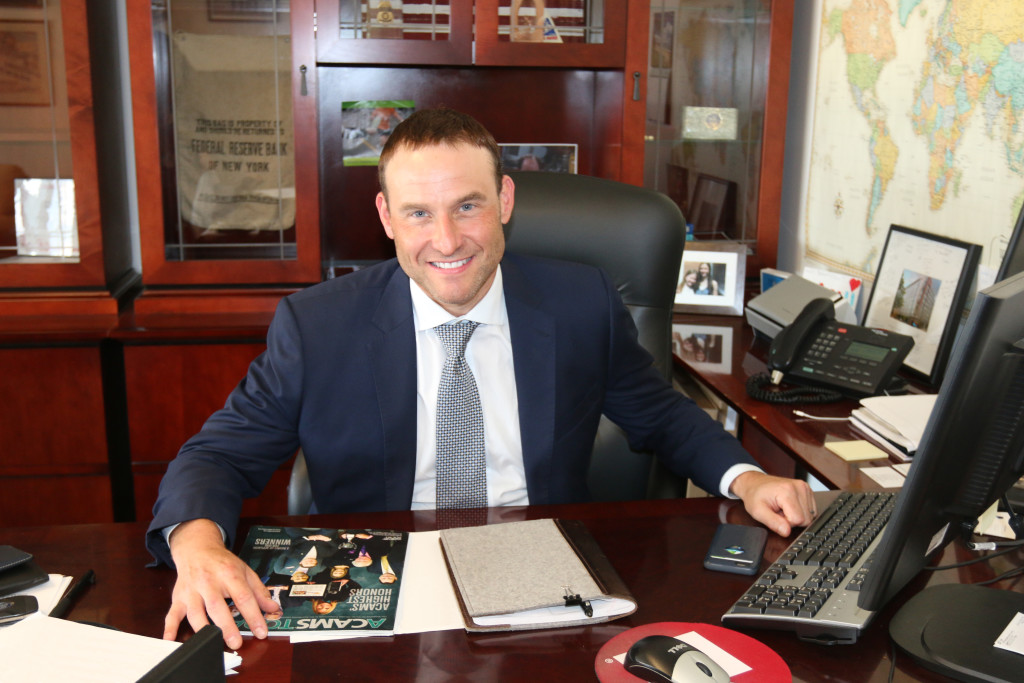
When we entered the building, I quickly realized how huge an entire New York City block really is. As we walked into the HSI EDTF headquarters, Erik told me, “Well, the first thing we need to do is get you a pass.” We approached what I imagined was a bulletproof window and I was asked to turn over my driver’s license. By the way, it did not matter that the person in charge of the HSI EDTF was standing right next to me; the gentleman at the window looked at my driver’s license picture to make sure I was the same person standing in front of him. He then filed my driver’s license and slipped my pass through the glass compartment. I was now an official guest of the HSI EDTF.
As the tour continued, Erik pointed to different hallways and explained where each one led. We went around a corner and reached his office. As he fired up his computer and we started planning the day, he told me that he had received word that there had been a big money laundering bust the night before and that there were three guests staying in the HSI EDTF hotel (holding cell). He asked if, during our tour, I would like to go for a visit. My response was a quick “Yes.”
Erik dove right in and began to share HSI EDTF’s mission, which is “To disrupt and dismantle transnational criminal organizations involved in money laundering and other financial crimes affecting New York, but our reach is worldwide.”
HSI EDTF’s mission seems simple enough, but when Erik began to describe the extent of HSI’s responsibilities, which range from financial crimes, anti-gang enforcement, cybercrimes, narcotic smuggling/trafficking to human rights violations to name a few, I was left in awe of the many areas of expertise encompassed by one single task force (TF). In striving to fulfill their mission, HSI EDTF is comprised of 30 federal, state and local participating agencies and over 200 federal, state and local investigators, intelligence analysts and prosecutors. “EDTF would be near impossible to replicate, but we collaborate with other HSI offices and our federal partners all over the country, in addition to foreign law enforcement organizations, to support their ongoing investigations and to help grow their financial crime investigations and financial intelligence functions,” Erik explained. The benefits of such a wide and diverse network of agencies and individuals is astounding. The size of the TF was reemphasized as we later walked through the office and passed a wall, which featured all of the official seals of the various agencies.
Erik went on to share the importance of deconfliction and how inter-agency communication within the HSI EDTF assists so that each agency is not duplicating efforts or arresting each other’s undercover agents or ruining well-executed sting operations.
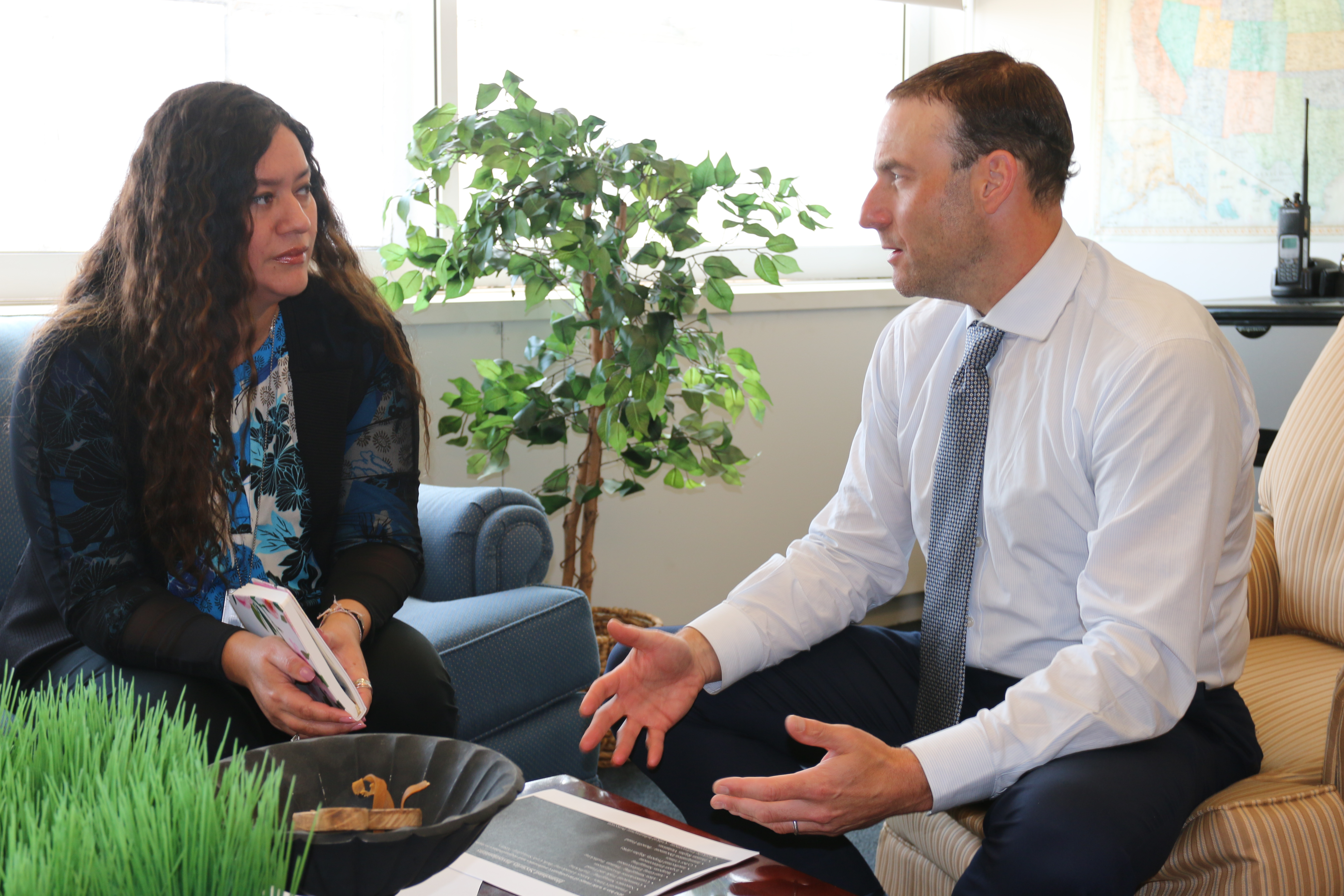
One thing that Erik mentioned that resonated with me is the business side of financial crime fighting. Due to the collaboration amongst all of the agencies, every time agencies pool their resources together, if assets are seized, each department participates in asset sharing to further assist in the fight against financial crime and other crimes that affect the partner agency’s hometown, such as combating the heroin and fentanyl epidemic. I asked Erik what was the biggest asset he had confiscated. He told me the most exciting was a jet, but the biggest was a commercial building.

Erik went on to share that HSI EDTF is passionate about its outreach program Cornerstone. At least a couple of times a month HSI EDTF provides trainings for the community on what individuals can do to assist in the fight against financial crime. Erik said, “We have an open door policy. We want to work with people to solve crime.” When asked why HSI EDTF has been so successful, Erik said, “HSI is a collaborative agency. This is why it works.”
During the tour, Erik received word that it would be a good time to visit the holding cells. As we made our way down to the floor on which the cells are located, we passed a couple of high-end stores, a gym and some locals, who as Erik put it, had no idea what was behind the non-descript door. As I passed through that door, I started to think about all the cop shows I had seen on TV and wondered if those fictionalized events would bear even a passing resemblance to the reality before me. I was not disappointed. After many past discussions with various members of the law enforcement community of their daily activities, it was gratifying to see first-hand a part of the investigation process. In seeing the HSI EDTF agents at work, I gained a greater appreciation for everything they do to keep our cities safe.
After our sojourn in the holding cells, we continued the tour by walking to the other side of the office city block before returning to Erik’s office where I would have the privilege of conversing with six members of the HSI EDTF.
Ryan, HSI Supervisory Special Agent
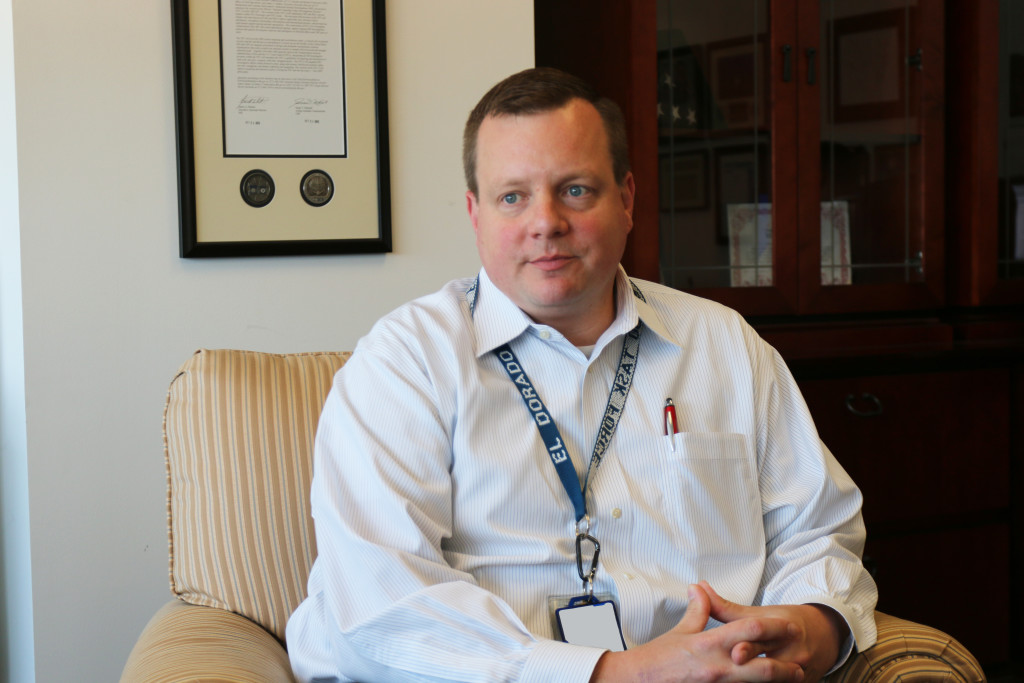
ACAMS Today: Could you tell me about your role and what you do on a daily basis?
Ryan: My group is tasked with looking at non-traditional money laundering investigations—so everything outside of narcotics money laundering. Currently, some of the investigations we are working on are Ponzi schemes, securities fraud, manipulations of securities and commodities. We have also targeted the proceeds of contraband, for example, cigarette contraband trafficking. This is an offense that is not typically prosecuted because it is difficult to get the requirements for it, but we have found that we can do undercover operations where we can get information from the organized network that is operating these rings of contraband cigarettes. For example, these organizations go to low-tax jurisdictions, like Virginia, to buy as many cigarettes as they can at a low cost. They then sell the cigarettes at a higher price in the Black Market, which allows for huge profits even though they employ couriers and runners to travel on the interstate. We have discovered that this type of contraband trafficking has been tied to Hawalas because criminals prefer to use illicit money laundering networks because they operate without any oversight. However, not all Hawalas are used for illicit money. Since illicit money investigations falls under our purview, a lot of our investigations have begun with illicit money movement. This is why many of our investigations have begun with a contraband cigarette trafficking investigation. For example, imagine that a state trooper in West Virginia has pulled over a courier, which then leads to a larger network dealing in K2 synthetic cannabinoid distribution. The K2 is so prolific it has melded into the contraband cigarette trafficking. We have noticed in our undercover investigations that the criminals do not want us to purchase K2 synthetic cannabinoid as much as they want us to sell them contraband cigarettes, so they can trade between contraband cigarettes from low-tax jurisdictions for K2. We are seeing an overlap between K2 and the contraband cigarettes and even though contraband cigarettes do not appear as a public safety, K2 is and the melding of the two is affecting the public safety.
AT: Would you say that it is related to synthetic opioids?
RH: It has been related to fentanyl and synthetic opioids.
AT: Could you expand on your work with commodities?
RH: We work closely with the Securities Exchange Commission (SEC) and we have recently started working closely with the U.S. Commodity Futures Trading Commission (CFTC). We worked on a case involving a woman that was a Harvard graduate and she played up her Harvard degree as a selling point to come across as a prolific trader. She even tried to say that she had an evolved trading rationale that would guarantee double-digit returns. She would take victims’ money and prepare false investor statements and this was to the tune of $23 million. The SEC was the original provider, but the CFTC was the organization that we worked with to identify her and gather the evidence to obtain her conviction and we were successful.
AT: What has been your favorite case?
RH: There was a Bangladesh organization made up of 15 to 20 individuals that had a very sophisticated way of conducting check fraud. They would create these high quality counterfeit checks and had access to great false IDs. They would then open bank accounts with banks and let them remain dormant for a six-month period. Because of the dormancy, the banks would relax their controls on these accounts. Then on a Friday, they would deposit a $15,000 check and would withdraw money from ATMs up to the ATM limits. They realized at some point that they could go to a casino and withdraw money to gamble. The casino would look at the customer’s bank statement and note that they did have $10,000 available, so they would give the $10,000 to the customer. This process was repeated up to a million dollars and it was not until Monday that the bank’s realized that the checks were counterfeit. And this was to the tune of $18 million.
AT: So how long was this fraud going on for?
RH: This fraud had been going on for so long that the individuals we arrested admitted that they had inherited this scheme from a previous generation who had retired and handed over their skillset to the next generation.
AT: How did you get a break in this case or what led to the arrest of these individuals?
RH: It was a piece of luck. It was a vehicle stop by the NYPD in Queens. The individual was stopped for a driving infraction, but the police officer noticed that they had quite a bit of checks and ID’s in the car. This is an offense in the city of New York. The detective that went by had just spoken to someone in the EDTF about this and he was wondering if this was related to the discussion he had with someone in our office. The detective called up the bank investigator that was handling the case and the bank investigator put us in touch with him.
The individual was brought to the EDTF and we noticed that he had a key to a storage locker. We sent a couple of investigators to watch the locker. It turned out that one of the calls the detainee made, which was in his native tongue, was something to the effect of “go empty the locker.” The locker was a treasure trove of documents that was needed for a conviction.
Bill, HSI Special Agent

AT: Could you tell me about your role with the HSI EDTF and what your team does?
Bill: I am part of the undercover operations. This means we have informants in South America who work with money brokers. The money brokers set up meetings with drug dealers and money launderers for our undercover agents. Our undercovers are then put in contact with these money launderers. We pose as money launderers and conduct what is called ‘money pickups’ to further the investigation. The drug traffickers who launder their money are usually Colombians and Mexicans; however, the game has shifted in the last decade to Dominicans in Queens and a little bit of Mexicans in the Bronx and it has gone from cocaine to heroin. Although the players and drugs have changed, what hasn’t changed is that the money is still going to Colombia and Mexico. Also, heroin has three times the street value that cocaine does; therefore, if criminals are going to risk their lives they are going to do it for heroin, where they can make three times the profit. The sad part is that 90 percent of heroin users were opiate users to begin with, but they have shifted over to heroin because it is easier to get and cheaper. This is a huge change from when I started my career.
AT: Your team arrested the detainees from last night that I visited earlier today with Erik at the HSI EDTF hotel, could you tell me what happened?
BB: The detainees from last night were arrested for narcotics and conspiracy; however, we do know that one of them laundered money, but at this time, we are not charging him with that until we wrap up the case and then we can rearrest them all on the money laundering charge.
So, that was last night’s case; but, two days ago we had a money pick up and it worked just the way it is supposed to. We watched two guys deliver a giant duffle bag full of cash to a known associate of the organization but we can’t hit the two guys because we have to protect our investigation. So, the two guys drove to another borough and someone delivered a bag to their car; however, the two guys are still off limits. So, we watched them drive to yet another borough and watched someone get into the car and leave the car with the bag. The guy who left the car is now free game. So, we were able to stop the guy and we discovered that the bag was filled with cash and the original two guys drove off and they never even realized what happened. In the end, by watching one target, we developed another target and we arrested him and seized the cash.
The interesting thing is that sometimes we will sit on a target for two months waiting for them to do the same exchange and they do not do it again. So, it does not always go as smoothly. Sometimes the criminals do the pickups every day and sometimes they do not do anything for months. This line of work is unpredictable.
Editor’s note: Bill had been up for over 24-hours when I did this interview with him. He was also out with his team when they arrested the three detainees I had seen earlier in the day. He is only one example of the many dedicated people I met during my visit at HSI EDTF.
AT: What was your most memorable arrest?
BB: Earlier this year we seized $4.1 million and three kilos of heroin. That case has generated almost $10 million in seizures in the last three years and 90 kilos of heroin and 18 arrests. We had a heroin seizure on that case two years ago that included 70 kilos of heroin and $2 million, which was the fourth largest heroin seizure in the country and the largest in the state of New York. The prosecutor said there was enough heroin in that seizure for every man, woman and child in New York to have a hit of heroin. So, it was rewarding to get heroin off the street. People ask, “Why fight the drug battle if you are not making a dent?” But you can make a dent. You are hurting the criminals financially. Stopping and dismantling is difficult, but slowing them down and getting them off the street makes a difference. Even though we are a financial group because we are doing narcotic proceeds, sometimes we run into narcotics by mistake and sometimes we will seize more by mistake than some street cops will seize their whole careers because we are trying to get the dirty money off the streets and then we get to prosecute the criminals.

AT: Do you have cases that go national or extend to other states?
BB: Yes, our drug trade teams come from Texas or Miami, Boston and Rhode Island. We deal mostly in the northeast and down the coast, but we have had some cases that have extended to California. For example, cocaine was being bought and shipped to California and to Canada, but since we focus on New York, we call the other offices in other states and send them our leads.
AT: What are other ways you follow the money besides your own covert operations?
BB: We work together with the different groups in HSI EDTF and we also do a lot of surveillance. It is extremely rewarding when we get the people arrested and prosecuted. For example, we had been surveilling the target from last night for six weeks, and when we stopped the suspect yesterday, the bag they had was empty. So, the next step was to search the car for money traps. We had a dog come and the dog confirmed that there was a scent of narcotics. So I ripped up the front seat cover and inside the front seat was a hidden compartment where the drugs were hidden. Everything is about hidden compartments. The interesting thing is that the driver gave us consent to search his car. Guilty people seem to want to be cooperative and they never think we will find anything. Criminals spend a lot of money outfitting their cars and homes with hidden compartments. The $4.1 million was all hidden in furniture.
AT: What has been your longest and shortest case?
BB: Four years and still ongoing is the longest case. The target is smart enough to never touch the money. So, I would like to catch that target before I retire. The shortest case was an hour.
Editor’s note: After the interview, Bill went back to work to continue his 24-plus hour shift.
Myles, NYPD Detective
AT: What does your day entail?
Myles: A lot of paperwork. The NYPD organized crime investigation unit is a very proactive unit because we initiate investigations. I also have a strong background in money laundering, specifically cases dealing with human trafficking and high-ring prostitution. When I arrived at HSI EDTF, I saw that no one specialized in these cases even though they were textbook money laundering cases. I am a subject-matter expert, much to my mother’s embarrassment, on high-end prostitution. It is a very interesting and unique sub-culture, particularly when you talk about money laundering and financial crimes. In my opinion, it has not received the exposure it should. There are two things that the sex industry relies on, one is advertising and the other is banking. The advertising is easy to stop.
AT: ACAMS Today has published articles on this topic, there have been sessions on human trafficking at ACAMS conferences and the response is always the same, people want to know what else can they do to help in the fight against human trafficking?
MM: They need to monitor more. For example, I presented at the annual El Dorado Task Force/High Intensity Financial Crime Areas (HIFCA) symposium where I went over how we would investigate a human trafficking case as a paper case. Toward the end of my presentation, I pointed out that when we arrest the owners of these human trafficking syndications, they always lead to other arrests or other cases. For example, HSI EDTF arrested a former NYPD officer as part of a crime family for a gambling charge. Incidentally, he was just arrested again for a bank mortgage fraud violation the other day.
AT: In the cases you have worked, are the victims of human trafficking local or international?
MM: There are two things two consider when chasing human traffickers. First, there has to be a base for the traffickers to set up shop (e.g., the Asian massage parlors or escort agencies). These girls come to a new country and then that is it. The human traffickers have certain terms like the Korean express or the Chinese express and you will find the victims in all parts of the country working. There is an organization behind all of this and the smart approach is for law enforcement and financial institutions to partner up and work together to resolve this. For example, how can we identify these human trafficking organizations? A human trafficking organization is not going to walk into a bank and open an account under ABC Escorts because no bank is going to tolerate this. However, if they walk into a bank and open an account under ABC Consulting LLC that they set up two weeks ago, the human traffickers now have a bona fide entity. And in my cases, that is the essence of money laundering because once the funds start to go through the entity that was created solely to conceal what the source of the funds is, then it is good to go. These human trafficking cases are textbook money laundering cases, but they are also very tight prosecution cases. The key element to getting these cases solved is aggressive prosecution. Second, many of these girls are transported across state lines. Another side to this is that many of the escort agencies are fronts for narcotics trafficking and frankly, there are loser men out there that call up these salons and order drugs and the girl delivers the drugs. If the girl does not have to have sex with the man then it is also a win for the girl and that is the way they look at it. It is an interesting sub-culture.
AT: Could you speak more about the financial aspect of the narcotics delivery side of human trafficking?
MM: Well, for example, if I owned a high-end escort agency my line to the women would be let’s get as many billable hours as we can, especially if I am sending them out to deliver drugs. For example, one of the things that I discuss during my presentations is to pay attention to multiple charges that occur on one credit card in the middle of the night. It would be suspicious if the company that is processing those charges is ABC Transportation Inc., in New York, but all those transactions are off by a dollar or two dollars because they want to trick the credit card software. So, the way it works is that when the girl arrives at the hotel room she asks the John for a driver’s license, another form of ID, a credit card, and to sign a verification slip. So the John does all this and the reason for this is to fight charge backs on the credit cards. And this all gets processed and it gets keyed in. All the charge backs are carbon copy slips. This is a great tell to know that this is a human trafficking organization. The owners of the trafficking rings do not want to give the girls devices that they can use to swipe the cards on because the owners want complete control.
AT: What was your most memorable case?
MM: A previous federal case called NY Confidential. The case took place in 2005-2006. The pimp’s name was Jason Itzler, aka, the King of all Pimps. He graduated law school and got into the sex trade and had his office right next door to 26 federal plaza, which is the home of the FBI in NY. He went from making $60,000 a month to $450,000 a month in six months and no one noticed. We prosecuted Paul Bogrine and he got RICO-ed1 in Newark by the FBI. He is currently serving six life sentences, plus 20 years for murdering witnesses and for witness intimidation. These cases always lead to other things and there is always something else.
Donna, HSI EDTF Senior Intelligence Analyst, Financial Intelligence/HIFCA
Margret, HSI EDTF Program Manager, Financial Intelligence/HIFCA
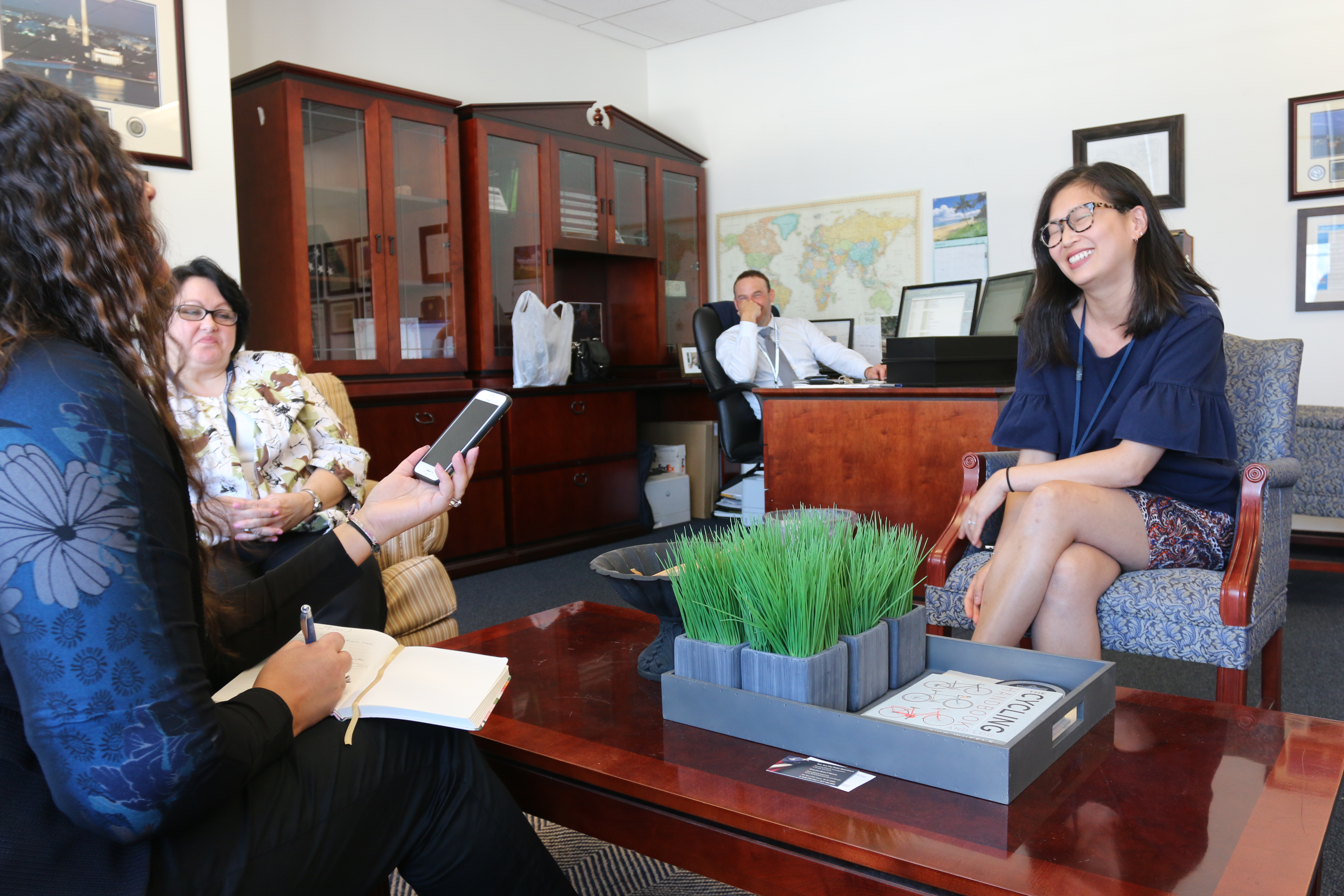
AT: Donna, what is your role with the HSI EDTF?
Donna: As the senior intelligence analyst for HSI, I have done several things with HIFCA over the years. I used to be in charge of SAR reviews. Now I am in charge of case support. What this means is that we receive a lot of requests from HSI EDTF agents and I work with our analyst to make sure they are doing the correct type of research and financial analysis, data visualization and putting it into a format that is understandable for everyone and appropriate for trial. One of our analysts recently went to testify at a trial. I have done threat assessments as well.
AT: Margret, what is your role?
Margret: I am the program manager at HIFCA. My job is similar to Donna’s. We function as deputies to Bill Macintosh, who is the supervisor of HIFCA. I work with the analysts specifically in complex multi-targets and strategic investigations. For example, I work on projects where we are pursuing a specific theme or issue rather than just an individual target set.
AT: Margret, what led you to join the HSI EDTF?
MM: I started in Washington, D.C., where I worked in the Treasury Department in the office of Intelligence and Analysis and prior to that I worked for the Department of Defense as a weapon’s analyst. The Treasury Department of Intelligence and Analysis is a sister office to OFAC, FinCEN and TFC.
After moving to New York, I was happy to be able to join the HSI EDTF and to see a different side of the illicit finance coin. In my previous job, the focus was on national security threats and international financial flows and that has been helpful for me in working with the types of cases that HSI EDTF receives. Working here has given me more exposure to the domestic side and the private sector.
AT: Is there anything peculiar or interesting that your analysts have found in a SAR?
MM: It is hard to pick just one because every SAR that turns into a referral has interesting aspects of their own. Analysts have worked on SARs that end up plugging into complex money laundering investigations or you will find a SAR that on its face does not appear very interesting that might be run of the mill narcotics related or a very low-dollar amount. But once you start putting the pieces together, it ends up leading you to a multi-million dollar trafficking network that expands across multiple states.
DL: In other words, something small can lead to something big.
AT: Do you use SARs to identify and choose your strategic investigations?
MM: Yes, SARs are our main source of information.
AT: Do you have any tips for financial professionals when they are filling out their SARs?
DL: Yes, we do quite a bit of community outreach through our Cornerstone program. We visit different financial institutions and we do training on how to write SARs better and on what we look for. We answer the who, what, where and how. We scan and target for certain terms. For example, writing down if the crime is human trafficking, narcotics related, or terrorist financing is helpful. The most important thing is being succinct. It is also important to include updated contact information because we do follow up and reach out to the banks for more information.
AT: What are the most common questions you receive when you are doing the training for financial institutions?
MM: The biggest one is what do you look for when reviewing SARs.
DL: HIFCA, in conjunction with HSI EDTF and the Federal Reserve Bank, sponsors a financial symposium. We have had panels on Fintech and block-chain technology. We invited over 300 people from the financial sector and law enforcement. This is a great opportunity for outreach. We also do the international leadership program through the state department. We have many leaders come in, such as top-level financial ministers and prosecutors from different countries, and we have discussions on how to foster better partnerships between the public and private sectors.
MM: One of the messages we want to get out to the financial sector is please do not be afraid to contact us.
Interview with Undercover Agent
I had the opportunity to meet an undercover agent while I was visiting HSI EDTF. For the purposes of this interview, we will call him Zachary. I have met a couple of undercover agents in the past, but I have never had an opportunity to sit down one-on-one and ask them questions.
When Zachary walked into the room, he was not what I expected. Zachary was all smiles and seemed like he had been working at a desk job his whole life, but the truth is that Zachary was recruited his senior year of college and has been an undercover agent for almost two decades. He has been all over the world and has handled cases in many jurisdictions. In fact, when I spoke with him he was handling at least ten sources in multiple countries. Zachary was able to share that many of his cases dealt with narcotics, smuggling and money laundering. He modestly stated that through his efforts, his team and his confidential informants (CIs), he has been able to catch a few bad guys and break up some smuggling rings.
I, of course, wanted to know if he could share a war story where he faced immediate danger. He graciously obliged and told me about his experience when meeting a drug dealer. The dealer was known to be violent and unpredictable. They scheduled to meet in an open field and the agent had plenty of back up. However, as he drove up to the field for the meeting, the surveillance helicopter kept getting too close and the agent had to wave them off more than once. As he arrived to the rendezvous already worried about his cover, the agent saw that the dealer was waiting for him. He got out of the car and approached the dealer. They started speaking and the dealer asked the agent to follow him to the rear of his car. The dealer opened the trunk and on top of some bags he had a machete. The dealer leaned into the car and began to stroke the blade of the machete with one hand. The dealer asked the agent if he was a cop and if the agent was going to betray him. The agent remained cool but knew if he gave the wrong response, his back up was too far away to prevent anything. The dealer was satisfied with the answer and they concluded their business.
Zachary later testified against the drug dealer and the drug dealer could not believe that Zachary was indeed an undercover agent after all.
Zachary like everyone else I met that day at HSI EDTF is passionate about what they do and I believe that the people and their passion is the secret to the TF’s success. Happy 25th HSI EDTF!
- This is a term used by law enforcement. It is referring to the Racketeer Influenced and Corrupt Organizations (RICO) Act, a “U.S. federal law that provides for extended criminal penalties and a civil cause of action for acts performed as part of an ongoing criminal organization.”







